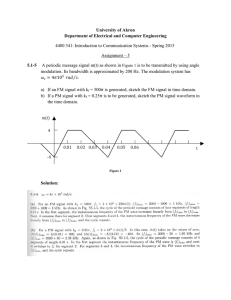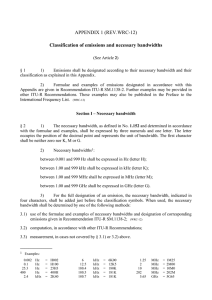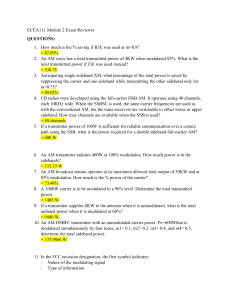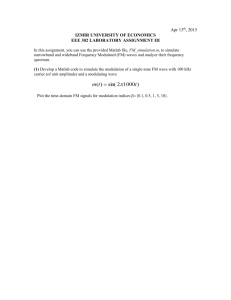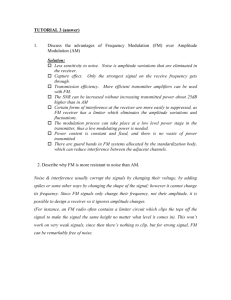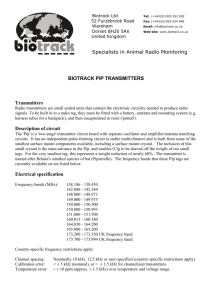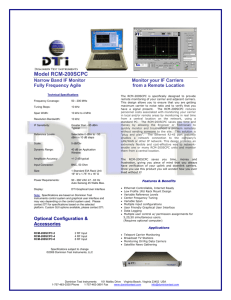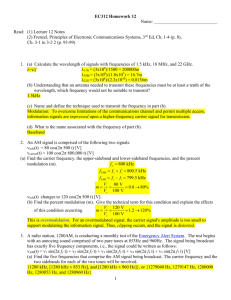NECESSARY BANDWIDTHS AND CLASSIFICATION
advertisement
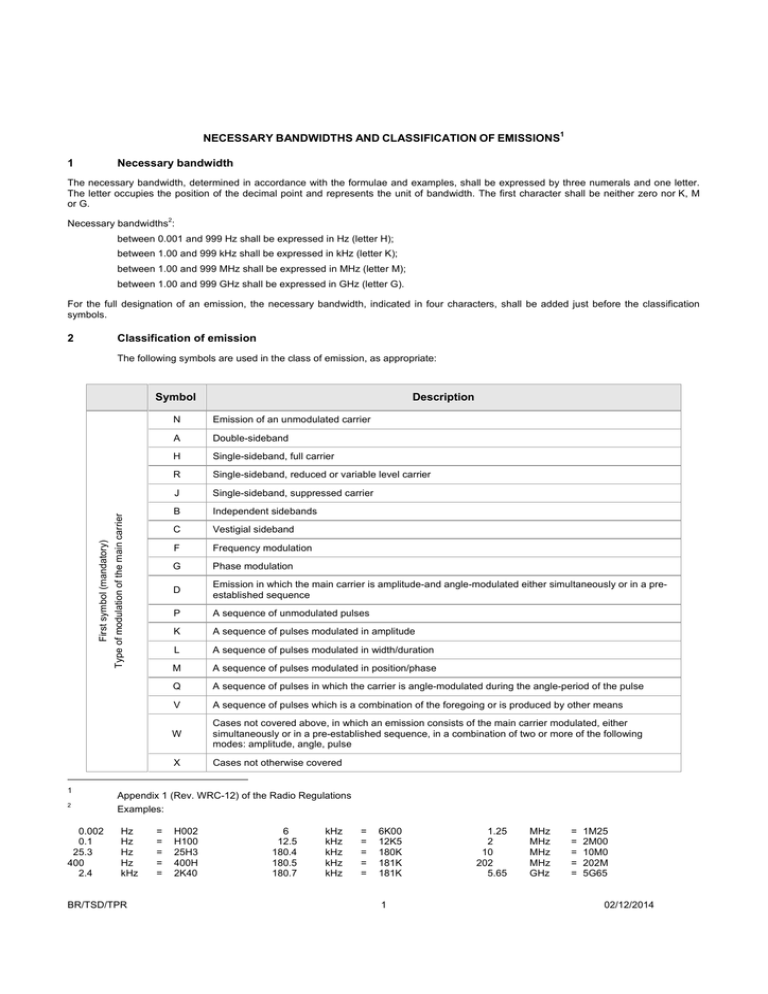
1 NECESSARY BANDWIDTHS AND CLASSIFICATION OF EMISSIONS 1 Necessary bandwidth The necessary bandwidth, determined in accordance with the formulae and examples, shall be expressed by three numerals and one letter. The letter occupies the position of the decimal point and represents the unit of bandwidth. The first character shall be neither zero nor K, M or G. 2 Necessary bandwidths : between 0.001 and 999 Hz shall be expressed in Hz (letter H); between 1.00 and 999 kHz shall be expressed in kHz (letter K); between 1.00 and 999 MHz shall be expressed in MHz (letter M); between 1.00 and 999 GHz shall be expressed in GHz (letter G). For the full designation of an emission, the necessary bandwidth, indicated in four characters, shall be added just before the classification symbols. 2 Classification of emission The following symbols are used in the class of emission, as appropriate: First symbol (mandatory) 1 2 0.002 0.1 25.3 400 2.4 Type of modulation of the main carrier Symbol Description N Emission of an unmodulated carrier A Double-sideband H Single-sideband, full carrier R Single-sideband, reduced or variable level carrier J Single-sideband, suppressed carrier B Independent sidebands C Vestigial sideband F Frequency modulation G Phase modulation D Emission in which the main carrier is amplitude-and angle-modulated either simultaneously or in a preestablished sequence P A sequence of unmodulated pulses K A sequence of pulses modulated in amplitude L A sequence of pulses modulated in width/duration M A sequence of pulses modulated in position/phase Q A sequence of pulses in which the carrier is angle-modulated during the angle-period of the pulse V A sequence of pulses which is a combination of the foregoing or is produced by other means W Cases not covered above, in which an emission consists of the main carrier modulated, either simultaneously or in a pre-established sequence, in a combination of two or more of the following modes: amplitude, angle, pulse X Cases not otherwise covered Appendix 1 (Rev. WRC-12) of the Radio Regulations Examples: Hz Hz Hz Hz kHz BR/TSD/TPR = = = = = H002 H100 25H3 400H 2K40 6 12.5 180.4 180.5 180.7 kHz kHz kHz kHz kHz = = = = = 6K00 12K5 180K 181K 181K 1 1.25 2 10 202 5.65 MHz MHz MHz MHz GHz = = = = = 1M25 2M00 10M0 202M 5G65 02/12/2014 Type of information to be transmitted Second symbol (mandatory) Third symbol (mandatory) Fourth symbol (optional) Details of signal(s) Nature of multiplexing Fifth symbol (optional) Nature of signal(s) modulating the main carrier Symbol BR/TSD/TPR Description 0 No modulating signal 1 A single channel containing quantized or digital information without the use of a modulating sub-carrier 2 A single channel containing quantized or digital information with the use of a modulating sub-carrier 3 A single channel containing analogue information 7 Two or more channels containing quantized or digital information 8 Two or more channels containing analogue information 9 Composite system with one or more channels containing quantized or digital information, together with one or more channels containing analogue information X Cases not otherwise covered N No information transmitted A Telegraphy – for aural reception B Telegraphy – for automatic reception C Facsimile D Data transmission, telemetry, telecommand E Telephony (including sound broadcasting) F Television (video) W Combination of the above X Cases not otherwise covered A Two-condition code with elements of differing numbers and/or durations B Two-condition code with elements of the same number and duration without error-correction C Two-condition code with elements of the same number and duration with error-correction D Four-condition code in which each condition represents a signal element (or one or more bits) E Multi-condition code in which each condition represents a signal element (of one or more bits) F Multi-condition code in which each condition or combination of conditions represents a character G Sound of broadcasting quality (monophonic) H Sound of broadcasting quality (stereophonic or quadraphonic) J Sound of commercial quality (excluding symbols K and L below) K Sound of commercial quality with the use of frequency inversion or band-splitting L Sound of commercial quality with separate frequency-modulated signals to control the level of demodulated signal M Monochrome N Colour W Combination of the above X Cases not otherwise covered N None C Code-division multiplex F Frequency-division multiplex T Time-division multiplex W Combination of frequency-division multiplex and time-division multiplex X Other types of multiplexing 2 02/12/2014
